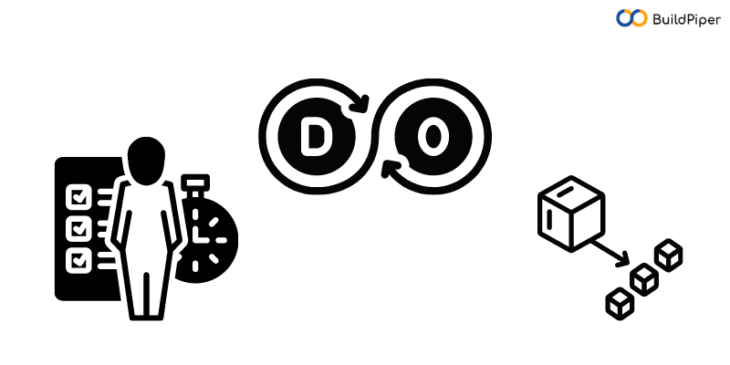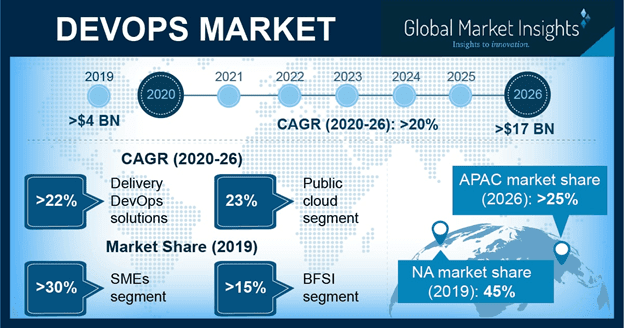
Consider these DevOps practices for rapid application delivery, seamless management of Microservices, and hassle-free product release.
Enterprises both big and small, are focusing on modernizing applications and implementing Microservices & DevOps architecture to boost their businesses’ agility and productivity. Enterprises are competing against tighter time-to-market windows than ever before. Seeing how mercurial markets have become now, there’s no time to waste when you have to create customer-facing applications that serve prospects and customers better than your competitors.
Today, migrating to the cloud, especially through cloud-native architectures such as Microservices, is a multidimensional problem. So, without a well-planned, sorted strategy and a well-devised DevOps roadmap, migration could become futile. You need to consider reliable strategies for adopting Cloud & DevOps architecture that can help deliver competitive strength to your organization and improve customer experiences through an agile & nimble tech platform.
Here, in this blog, I’ve discussed some important practices of adopting DevOps architecture to enable rapid application delivery, seamless management of Microservices, and hassle-free product release thus allowing your business to scale and exceed customer expectations!

Basic DevOps Practices- Core Principles!
Before we dive into specific DevOps techniques and approaches to help your business succeed with Microservices, let’s look at some of the core ideas behind these types of architectures:
- Microservices should be deployed at a faster pace.
- Security should be a major focus area.
- Comprehensive Monitoring and logging
Moreover, applying these approaches can help your IT teams in designing the right DevOps roadmap best-suited to meet the requirements of Microservices implementation in your organization.
But, executing each of these approaches and ideas poses its unique challenges. Let’s read further to know why embracing these DevOps practices is important if you’re thinking about Microservices.
[Good Read: Top 3 DevOps Monitoring Strategies]
Microservices should be deployed at a Faster Pace!
In a monolithic approach, fewer deployments are happening as compared to Microservices. What earlier was a single monolith application, now becomes a large collection of 50–200 services. Therefore, with Microservices, your team needs to be prepared for 100 times or even more deployment than ever before. With increased challenges, a slow pace of deployment would fail to support fast-moving Microservices. Moreover, the independent nature of Microservices poses additional difficulties.
Microservices have their independent code which needs to be deployed individually for each of these microservices without affecting the other modules of the application. Microservices are loosely coupled and need not have the same technology stack, libraries, or frameworks.
The deployment process for services differs from each other and thus needs to be done at a faster pace to enable production-ready Microservices. Along with improving the pace of Microservices deployment, it’s important that teams have the adequate DevOps skillset required to manage Microservices in a secured and seamless manner.
- Automate everything- Automation should become a crucial part of the development process.
- Operational excellence is a must– Strategies for continual improvement are important to increase the velocity.
- Operation activities must work closely with the Development process– Ensure that the basic operational activities work along with the development process. This helps in enabling a faster deployment process.
By executing these simple yet so important DevOps practices, you can be assured of the complete security of your business application. Implementing Microservices without changing the way you execute the business operations may put your projects at risk.
Besides a well-planned DevOps roadmap, there is a need for the IT teams to possess appropriate DevOps skillset for implementing practices of DevOps architecture.
Security should be a Major Focus Area!
Independent deployments, business-oriented capabilities, agile teams, functional orientation, and rapid application delivery are some of the unique characteristics of Microservices. With all these changes, brought in the Microservices-led DevOps architecture, it should come as no surprise that the approach to security needs to change as well. Here’s what you can do to adopt a Shift Left Philosophy and embed security early on!
- Involve experts to monitor complete security- Experienced security experts to monitor iterative product features. This helps to get early feedback on the security status of the application.
- Implement security measures while detecting errors– Robust security measures in the bug tracking process should be adopted.
- Integrate best security practices in the code review– Authentic and reliable security practices in the code review process must be executed, especially if you have to deal with authentication flows, configurations, secret storage, etc.
- Move towards automation as much as possible– Automation techniques for application security can be adopted. Automated security practices such as dependency scanning and static analysis can become part of your deployment pipeline.
It’s important that you first analyze and then select the best security practices for your business applications. Make sure to devise a plan to implement the security measures not towards the end but proactively during the development process.
Comprehensive Monitoring & Logging
Last but not least make sure to select the right approach for logging and monitoring Microservices. When you’re working with a single application, you usually get a chance to look at the logs and have a clear picture of what exactly is happening.
But what, if you have to deal with 20 applications( to be scaled dynamically), you surely need a different strategy then. The same is the case with Microservices where you have to work with many services. Logging and monitoring these services is a cumbersome and tedious process.
Therefore, it is important to introduce state-of-the-art logging and monitoring practices for enabling production-ready Microservices. Being able to track all the requests across different microservices is a must. Viewing these logs in one place is the only way to make things work.
Implementing & configuring all of this often becomes a huge challenge and thus a need for the platform to seamlessly manage Kubernetes and Microservices is highly recognized. Take a look at how BuildPiper provides out-of-the-box capabilities for Kubernetes & Microservices application delivery management.
With BuildPiper, you can benefit from comprehensive automation for the entire Microservices journey right from K8s cluster setup & config, onboarding microservices, robust security-enabled CI-CD engine, and complete observability that enables viewing of the overall performance, health status, availability, logs, and other important metrics of your services & Kubernetes components.
With the integration and set-up of infrastructure monitoring and log management tools such as Prometheus, Grafana, Alert Manager, ElasticSearch, Fluentd, and Kibana, BuildPiper enables complete observability with detailed information on build and deploy logs.
BuildPiper provides your DevOps team with deep insights into the services to monitor & analyze app performance and the right DevOps skillset for enhancing the application performance.
Wrapping it All
These are some of the DevOps practices to make your Microservices journey successful. So, before you plan to implement these DevOps strategies, make sure to look at the pros and cons of each of these. Analyze and then decide which would work best for your platform.
BuildPiper is an End to End Microservices Delivery Platform.



